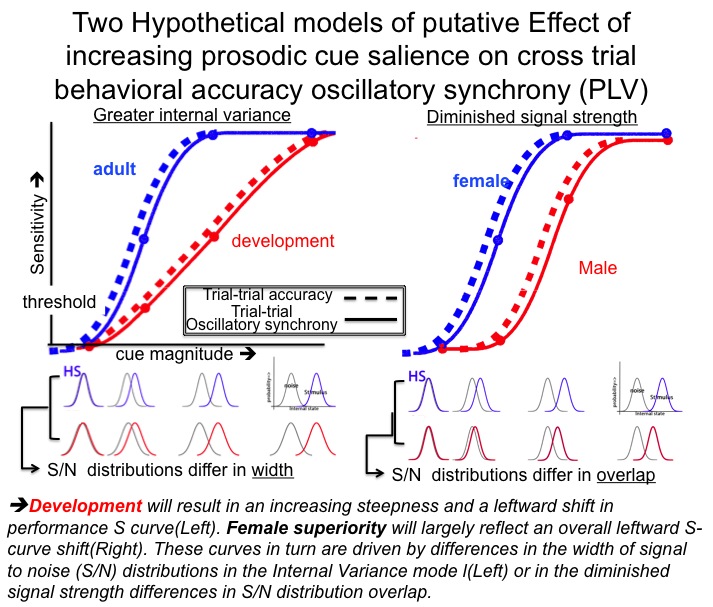R01 Specific Aims
 1. Examine prosody as a construct of this social communication by examining how variation in prosodic abilities correlate with structural functional brain changes from adolescents to early adulthood
1. Examine prosody as a construct of this social communication by examining how variation in prosodic abilities correlate with structural functional brain changes from adolescents to early adulthood2. Assess the degree to which individual differences in prosodic accuracy not attributable to age relate to individual differences in sociability and to what extent are individual levels explained by individual differences in prosodic brain mechanisms
3. Examine the degree to which gender prosody differences are mediated by prosodic brain mechanisms and individual or group (female vs. male) differences in sociability.
R01 Aims
- Aim 1: Hypotheses:
- We hypothesize that cortical maturation of the dorsal and ventral auditory pathways that underpin the prosodic neural network will have the effect of increasing the reliability and precision of prosodic processing (figure): Specifically, that:
- Relative to adults (ages 18-45) and adolescents (12-18) will display reduced trial-trial identification accuracy and gamma band phase-locking (PLV) within network ROI’s as a function of signal ambiguity.
- These changes will be accompanied by diminished communication efficiency between ROI’s within the network as measured Mutual information peak magnitude and latency.
- Brain-behavior changes will relate to between-group neurostructural developmental differences in auditory pathways (DWI &Myelin mapping).
- We hypothesize that cortical maturation of the dorsal and ventral auditory pathways that underpin the prosodic neural network will have the effect of increasing the reliability and precision of prosodic processing (figure): Specifically, that:
- Aim 2: Evaluating the role of individual differences in sociality on prosodic brain mechanism and prosodic ability.
- Prior studies employing the need to belong scale (NTB) indicate that variation in individuals ratings of the importance to connect with others significantly predict prosodic accuracy.
- Hypothesis: Individual differences in NTB ratings irrespective of age will explain variations in prosodic abilities not accounted for by our brain network estimates (i.e. ROI Gamma-PLV; ROI2ROI communication).
- Aim 3 (Exploratory): Evaluating the role of gender on prosodic brain mechanism and prosodic ability.
- Prior data indicate female superiority in prosodic identification. Additionally, we have preliminary indications of higher need to belong ratings in females. These results are consistent with numerous findings of female social communication superiority possibly reflecting the higher intrinsic salience social communication has for women.
- We will preliminarily examine whether and to what degree gender mediates brain network precision and subsequent prosodic abilities independent of age
Two Hypothetical Models of Putative Effect of Increasing Prosodic Cue Salience on Cross Trial Behavioral Accuracy Oscillatory Synchrony (PLV)
Approach
- 1st step: Smart Subject Screening for Neuroimaging: assessment of pitch and prosodic abilities and personality assessments of loneliness, need to belong (social connectedness) and isolation (social network density), as well as depression and social anxiety assesments
- 2nd step: Multimodal Imaging of Prosody and Pitch Perception: Multimodal Neuroimaging (EEG-MEG, fMRI, & DWI) of prosody and pitch on selection of 92 (46 male, 46 female) subjects to equally reflect low, medium, and high personality scores.
- 3rd step: Feasibility for Large Scale Portable Study: Preliminary comparison of relative sensitivity differences between multimodal imaging assessment and behavior and EEG assessment during prosody and simple tones at and twice threshold alone
Ancillary Functional Goals
- Facilitate developmental studies in clinical research and translational approaches to social communication
- Link individual differences on cue salience modulated prosody oscillations to elemental pitch magnitude modulated oscillations to simple tones
- This link would allow future clinical neuroscience to focus on a simpler phenomena and one that can translate into animal models
- Low cost portable assessment
- Comparing the sensitivity of multimodal neuroimaging with EEG and behavioral estimates and or estimates of PLV to simple sounds explain individual differences as well as multimodal data collection

Comments are closed.